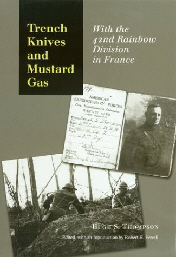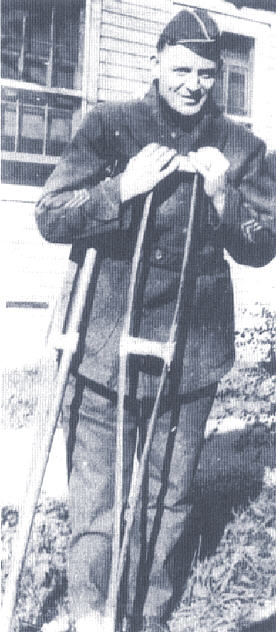A Special Contribution Courtesy of
Professor Robert H. Ferrell
 Trenches Similar to those Discussed HereWallace continued to hand out useful information. Emergency rations of hardtack and bully beef were not to be opened without orders. Sealed tins of emergency water in company and platoon dugouts were treated with like respect, chow details issuing a canteen ration daily. This supply had to serve for drinking, teeth-brushing, etc. Messages between battalion headquarters and company and platoon positions were usually written and carried by runners. Liaison patrols constantly kept the isolated positions in touch with one another. The patrols also ensured that the connecting stretches of trench would be kept clear of all but friends.  The 168th Infantry on ParadeWe left the clearing, skidded down a steep communicating trench, and crossed a low place. A bullet pinged overhead; Wallace grinned widely when Malcolm and I ducked in unison. Three shells swished over us in rapid succession and exploded in the direction of Badonviller. I began to get a bit uncomfortable over what was in store for us. Floundering through mud, we crossed a brook, passed another rustic grave, and pulled up in front of a chicken-wire gate. A sentinel admitted us into another trench. We splashed by a muddy group that worked with shovels in the trench bottom. Floundering around a corner, we came to a dugout and adjoining shelter, covered with sunken hoods of corrugated iron. A doughboy stood by the blanketed entrance to the dugout. Another, with rifle and bayonet, lay on his belly upon a pile of mud atop. We were at the platoon headquarters of GC9.
We retraced our difficult steps, following our guide to the neighboring platoon positions. We lurched down soupy, demolished trenches toward GC to. Men in rubber boots, hip high, grunted with shovels, here and there. Others worked in the tangles of mud, splintered stanchions, broken telephone cable, and twisted iron. A Boche plane buzzed overhead as we approached a dark cavity in the earth filled with splintered debris. It was the place where Capt. McHugh had been killed in the German bombardment of the first battalion. Doughboys with automatic rifles were in outposts jutting out along the line. Two men sat at each gun, while another pair slept under metal and sandbag shelters, close at hand. A heavily manned outpost between GC to and GC11 had its gun set up among the ruins of a farmhouse with the muzzle stuck through a wide slit in a tumbled-down chimney. More men slept in a waterlogged cellar below. A German helmet hung from a spike in the chimney’s mortar, raw flesh and tufts of black hair protruding from the lining. Wallace took us into GC it, which was out of his company sector. He had a special reason. We were greeted by a sickening odor, as he led us around a turn in a sloppy ditch. The body of a dead German, in muddy, green-gray overcoat lay on the trench bottom. |
|||||
|
Sources and thanks: Professor Ferrell is spending his retirement focusing on the AEF. His edited version of Lt. Thompson's manuscript is one of eight projects he is developing. Check back for more of his contributions to the Doughboy Center. MH |
To find other Doughboy Features visit our |
Membership Information  Click on Icon |
For further information on the events of 1914-1918
visit the homepage of |
Michael E. Hanlon (medwardh@hotmail.com) regarding content,
or toMike Iavarone (mikei01@execpc.com) regarding form and function.
Original artwork & copy; © 1998-2000, The Great War Society

